The Cryptogenic Stroke Treatment Market is estimated to be valued at USD 3.8 billion in 2025 and is projected to reach USD 8.6 billion by 2035, registering a compound annual growth rate (CAGR) of 8.4% over the forecast period.
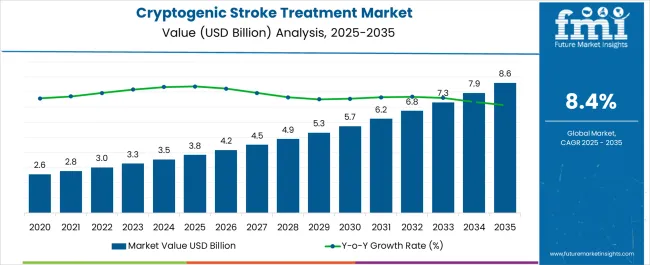
| Metric | Value |
|---|---|
| Cryptogenic Stroke Treatment Market Estimated Value in (2025 E) | USD 3.8 billion |
| Cryptogenic Stroke Treatment Market Forecast Value in (2035 F) | USD 8.6 billion |
| Forecast CAGR (2025 to 2035) | 8.4% |
The Cryptogenic Stroke Treatment market is witnessing steady growth due to the increasing prevalence of undiagnosed and unexplained strokes, particularly among aging populations. Treatment strategies are evolving with a focus on minimizing recurrent stroke risks through targeted drug therapies and structured care pathways. Investments in healthcare infrastructure, particularly in hospitals and specialized stroke centers, are supporting enhanced patient access to effective therapies.
Growing awareness among healthcare providers and patients regarding the benefits of early intervention and continuous monitoring is further contributing to market expansion. Advances in anticoagulant formulations, along with emerging clinical evidence supporting their use in cryptogenic stroke prevention, are encouraging physicians to adopt these therapies more widely.
Additionally, the emphasis on patient adherence, safety profiles, and individualized treatment regimens is shaping the adoption trends across different healthcare settings As global healthcare systems continue to prioritize stroke prevention and long-term patient management, the Cryptogenic Stroke Treatment market is expected to maintain consistent growth, driven by both established and emerging treatment paradigms.
The cryptogenic stroke treatment market is segmented by drug type, distribution channel, and geographic regions. By drug type, cryptogenic stroke treatment market is divided into Anticoagulants, Antithrombotic, Antiplatelet Therapy, Clopidogrel, Aspirin, and Other. In terms of distribution channel, cryptogenic stroke treatment market is classified into Hospital Pharmacies, Retail Pharmacies, and Drug Stores. Regionally, the cryptogenic stroke treatment industry is classified into North America, Latin America, Western Europe, Eastern Europe, Balkan & Baltic Countries, Russia & Belarus, Central Asia, East Asia, South Asia & Pacific, and the Middle East & Africa.
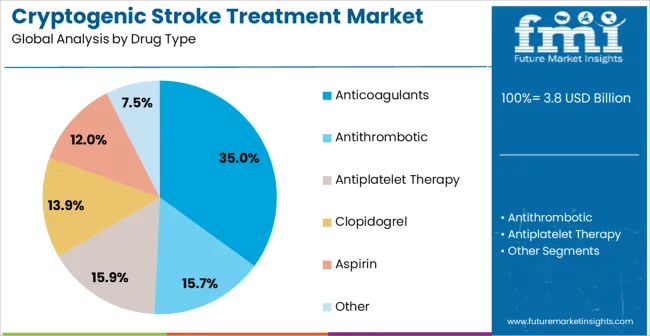
The Anticoagulants drug type is projected to hold 35.0% of the Cryptogenic Stroke Treatment market revenue share in 2025, positioning it as the leading therapy class. This prominence is being attributed to its proven efficacy in preventing thromboembolic events and reducing recurrent stroke risks in patients with unexplained strokes.
Adoption has been strengthened by the development of direct oral anticoagulants that offer predictable pharmacokinetics, improved safety profiles, and lower monitoring requirements compared to traditional therapies. Physicians are increasingly recommending anticoagulants for patients with specific risk factors, supported by clinical guidelines emphasizing stroke prevention and long-term patient management.
The segment has also benefited from broader availability in healthcare systems and growing patient acceptance due to oral administration convenience and established therapeutic outcomes Future growth is expected as clinical evidence continues to demonstrate their benefit in cryptogenic stroke populations, coupled with ongoing education of healthcare providers and patients regarding optimized anticoagulant use.
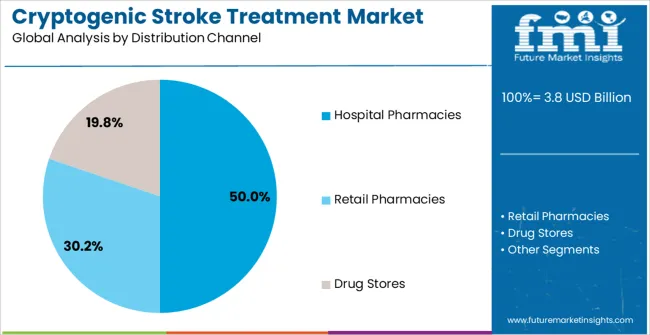
The Hospital Pharmacies distribution channel is anticipated to account for 50.0% of the market revenue in 2025, making it the dominant channel for Cryptogenic Stroke Treatment therapies. This leadership is being driven by the concentration of specialized stroke care and patient management within hospital settings, where monitoring and tailored treatment regimens are critical.
Hospital pharmacies facilitate secure and regulated access to anticoagulants and other advanced therapies, ensuring adherence to treatment protocols and reducing the risk of medication errors. Additionally, integration with hospital-based clinical decision support systems allows for optimized dosing and patient-specific therapy adjustments, enhancing clinical outcomes.
The growing number of dedicated stroke centers and hospital networks adopting structured stroke prevention programs has further supported this segment Future growth in this channel is expected to be reinforced by increasing hospital investment in pharmacy infrastructure, greater patient throughput, and the implementation of standardized care pathways that rely on timely drug administration and monitoring for patients recovering from cryptogenic strokes.
Stroke is the fifth leading cause of death in United States and long term disability. Stokes are the major public health issue globally with one third of the ischemic strokes are generally cryptogenic stroke. Cryptogenic strokes are brain infractions which do not clearly attribute to definite cardioembolism, large artery atherosclerosis or small artery disease despite extensive research.
Atrial fibrillation is the major cause of stoke which increase the risk of stroke to more than 5 times. Stroke is caused by the blood clot blocking the flow of blood from heart to brain which is commonly known as ischemic stroke. Most of the cryptogenic stroke are embolic in origin, which arises from proximal arterial sources, heart or venous sources.
The stroke is considered to be cryptogenic after clinical examination and brain imaging. Increasing use of antiplatelet therapy as first line treatment option in patients with cryptogenic stroke treatment open up new opportunity for the cryptogenic stroke treatment market to grow in the forecast period.
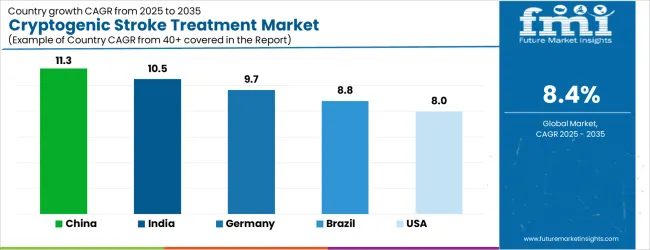
| Country | CAGR |
|---|---|
| China | 11.3% |
| India | 10.5% |
| Germany | 9.7% |
| Brazil | 8.8% |
| USA | 8.0% |
| UK | 7.1% |
| Japan | 6.3% |
The Cryptogenic Stroke Treatment Market is expected to register a CAGR of 8.4% during the forecast period, exhibiting varied country level momentum. China leads with the highest CAGR of 11.3%, followed by India at 10.5%. Developed markets such as Germany, France, and the UK continue to expand steadily, while the USA is likely to grow at consistent rates. Japan posts the lowest CAGR at 6.3%, yet still underscores a broadly positive trajectory for the global Cryptogenic Stroke Treatment Market. In 2024, Germany held a dominant revenue in the Western Europe market and is expected to grow with a CAGR of 9.7%. The USA Cryptogenic Stroke Treatment Market is estimated to be valued at USD 1.4 billion in 2025 and is anticipated to reach a valuation of USD 1.4 billion by 2035. Sales are projected to rise at a CAGR of 0.0% over the forecast period between 2025 and 2035. While Japan and South Korea markets are estimated to be valued at USD 197.8 million and USD 132.3 million respectively in 2025.
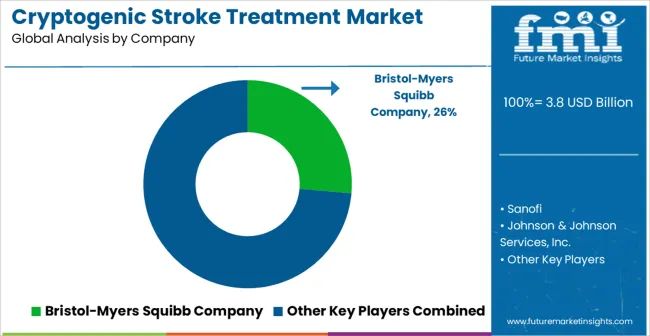
| Item | Value |
|---|---|
| Quantitative Units | USD 3.8 Billion |
| Drug Type | Anticoagulants, Antithrombotic, Antiplatelet Therapy, Clopidogrel, Aspirin, and Other |
| Distribution Channel | Hospital Pharmacies, Retail Pharmacies, and Drug Stores |
| Regions Covered | North America, Europe, Asia-Pacific, Latin America, Middle East & Africa |
| Country Covered | United States, Canada, Germany, France, United Kingdom, China, Japan, India, Brazil, South Africa |
| Key Companies Profiled | Bristol-Myers Squibb Company, Sanofi, Johnson & Johnson Services, Inc., Boehringer Ingelheim GmbH, F. Hoffmann-La Roche (Genentech), Daiichi Sankyo Company, Limited, Amgen Inc., and AstraZeneca |
The global cryptogenic stroke treatment market is estimated to be valued at USD 3.8 billion in 2025.
The market size for the cryptogenic stroke treatment market is projected to reach USD 8.6 billion by 2035.
The cryptogenic stroke treatment market is expected to grow at a 8.4% CAGR between 2025 and 2035.
The key product types in cryptogenic stroke treatment market are anticoagulants, antithrombotic, antiplatelet therapy, clopidogrel, aspirin and other.
In terms of distribution channel, hospital pharmacies segment to command 50.0% share in the cryptogenic stroke treatment market in 2025.






Full Research Suite comprises of:
Market outlook & trends analysis
Interviews & case studies
Strategic recommendations
Vendor profiles & capabilities analysis
5-year forecasts
8 regions and 60+ country-level data splits
Market segment data splits
12 months of continuous data updates
DELIVERED AS:
PDF EXCEL ONLINE
Stroke Catheters Market Analysis - Size, Share, and Forecast Outlook 2025 to 2035
Stroke Assistive Devices Market
VR Stroke Rehabilitation Market Insights – Growth & Trends 2023-2033
Ischemic Stroke Aspiration Systems Market - Trends & Forecast 2025 to 2035
Hemorrhagic stroke Treatment Market Size and Share Forecast Outlook 2025 to 2035
Ischemic Cerebral Stroke Prevention Therapeutics Market
Treatment-Resistant Hypertension Management Market Size and Share Forecast Outlook 2025 to 2035
Treatment-Resistant Depression Treatment Market Size and Share Forecast Outlook 2025 to 2035
Treatment Pumps Market Insights Growth & Demand Forecast 2025 to 2035
Pretreatment Coatings Market Size and Share Forecast Outlook 2025 to 2035
Air Treatment Ozone Generator Market Size and Share Forecast Outlook 2025 to 2035
CNS Treatment and Therapy Market Insights - Trends & Growth Forecast 2025 to 2035
Seed Treatment Materials Market Size and Share Forecast Outlook 2025 to 2035
Acne Treatment Solutions Market Size and Share Forecast Outlook 2025 to 2035
Scar Treatment Market Overview - Growth & Demand Forecast 2025 to 2035
Soil Treatment Chemicals Market
Algae Treatment Chemical Market Forecast and Outlook 2025 to 2035
Water Treatment Market Size and Share Forecast Outlook 2025 to 2035
Water Treatment Ozone Generator Market Size and Share Forecast Outlook 2025 to 2035
Water Treatment Equipment Market Size and Share Forecast Outlook 2025 to 2035

Thank you!
You will receive an email from our Business Development Manager. Please be sure to check your SPAM/JUNK folder too.
Chat With
MaRIA